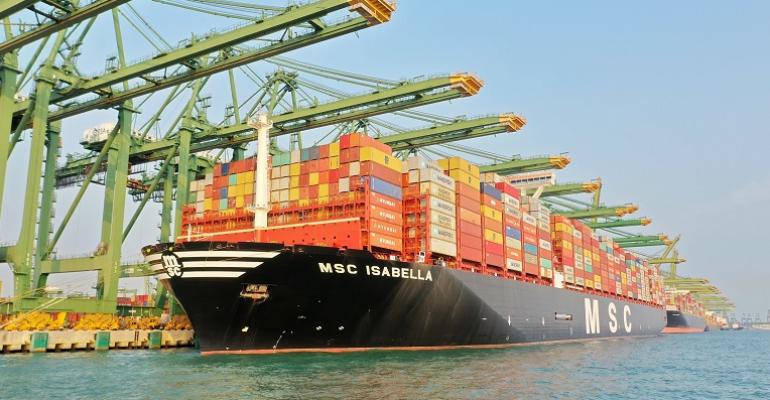Stability for European importers in such a major trade is critical, but elusive. And the drivers for change are not only on the supply side, but will be further complicated by demand developments, shocks, and realignments as geopolitical and economic pressure builds.
On the carriers’ side of the equation senior shipping analyst at Alphaliner Stefan Verberckmoes, concedes that “The situation will become completely different if ships can sail safely through the Red Sea again.”
Though he said this is unlikely to be an option in the short term.
In the Alphaliner analysis, however, Ocean Alliance has lost its leadership in the trade to MSC which has seen a 54% increase in its fleet on the trade, adding a spectacular 488,000 teu, “almost half of the overall 1 million teu capacity injection since February 2023,” according to Alphaliner analysis.
MSC’s capacity injection includes a 279,000 teu addition to 2M services, while the carrier also operates another 208,000 teu in its stand-alone services.
2M is now the largest alliance on the Asia to Europe trades, with a 33.4% market share, just eclipsing Ocean Alliance’s 33%, but far ahead of THE Alliance’s 23%, compared to February 2023 figures. Last year THEA had a 26% market share, 2M 32.4% and Ocean Alliance 37.5%.

Ocean’s decline in market share is because the carriers “did not take delivery of many newbuildings and are still struggling to fully staff all their Asia-Europe loops,” said Alphaliner.
The decline in THEA’s market share is largely down to the suspension of the Southeast Asia to Europe, FE5, loop in November last year. But Ocean Network Express (ONE) has increased its capacity due to the delivery of six vessels of over 24,000 teu each.
Verberckmoes’ views this as a temporary challenge: “Newbuildings always come in waves per carrier. The members of the Ocean Alliance have indeed many ships under construction, but that also includes deliveries only in 2026, 2027, and 2028.”
![Chart 3[75].jpg Chart 3[75].jpg](/sites/cet.com/files/Chart%203%5B75%5D.jpg)
Speaking up for shippers James Hookham, recognised the fluidity in the European trades that used the Suez Canal before December last year, but have now virtually all diverted vessels via the longer cape route, absorbing excess capacity.
Expectations that the geopolitical tensions in the Middle East, between Israel and the Palestinian authorities in Gaza and the West Bank will ease later this year could revive services heading to North Europe and the Mediterranean region on the much shorter Suez route.
If, and when, that happens Hookham believes, “We’ll be back to early December when the Red Sea crisis kicked-off, and it wasn’t looking good then.”
Hookham argues that rates will crumble, and “Average unit costs will again exceed average unit revenue, producing a negative yield, on a global basis.”
In addition to the declining revenues carriers could see a further decline in demand as trade again falters, elections in Europe, the US, India, and the UK mean that there is considerable uncertainty in the market.
“At times like these the focus should shift from price to what else can I do for my customers,” said Hookham, who accepted and welcomed the Gemini Cooperation move, which may bring such customer focused services to fruition next February.
Nevertheless, Hookham reprised an earlier warning to shippers to include a ‘return to Suez’ clause in this year’s contract negotiations. And with Gemini expected to change the market terrain again the variables in this market have become a serious obstacle to planning.
Emily Stausbøll, Xeneta market analyst, said: “The market share for alliances, and MSC alone, will change in 2025 regardless of whether or not container ships are sailing through the Suez Canal next year.”
Xenata believes “a recalibration of the services offered by new and existing alliances,” will happen but Stausbøll points out “this will be determined by developments on this trade - as well as other trades. Carriers will respond in a way that maximises revenue, just as they always have done.
“The picture will be different but fundamentally the motivations behind carriers’ decision making will be the same.”
From next year, however, Gemini will offer seven Asia – Europe loops and Verberckmoes calculates that If they use vessels of 18,000 teu per loop, that will total around 1.5 million teu in capacity. Currently 2M and Ocean Alliance each have a 2.1 million teu networks on the trade.
“The sum of the current fleets of Maersk and Hapag-Lloyd on the trade is 1.34 million teu. MSC alone has 1.14 million teu and THEA next year, including ONE, HMM and Yang Ming will deploy 1.1 million teu without Hapag-Lloyd.
“The Ocean Alliance (2.1 million teu) will obviously be the biggest alliance by far. There will likely be slot swap deals between the carriers as we already see on the transpacific, where ONE is buying space on three Ocean Alliance loops,” said Verberckmoes.
Another feature of the current flux in the Asia to Europe trades is pointed out by Antonella Teodoro, a senior consultant at MDS Transmodal, “All major players have reduced their offers on the services via the Arabian Gulf and Indian Sub-Continent, with this gap now attracting ‘other’ carriers, which now offer around 12% of the capacity deployed on this route.”
That has seen the capacity scheduled to be deployed on direct Far East – Europe services are up, and, in contrast, capacity scheduled to be deployed on the Far East – Europe via the Gulf and the Sub-Continent has declined.
“In my view this 12% of tonnage deployed by others calling at Gulf and Sub-Continent ports is not going to last, when you look at the share they cover on all Far East – Europe routes, then you see that they account for 4.9% in 2024 Q1 vs 3.6% in 2023 Q1,” added Teodero.
Copyright © 2024. All rights reserved. Seatrade, a trading name of Informa Markets (UK) Limited.
Add Seatrade Maritime News to your Google News feed.  |

